| Encyclopedia of Tours and Travel to Maharashtra, featuring information on Fairs & Festivals, Wildlife, Excursion, Adventure and Weather of Maharashtra. |
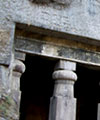 |
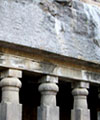 |
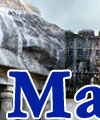 |
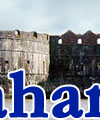 |
 |
 |
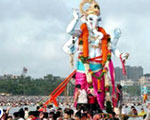 |
||
|
Excursion
Caves Be it the paintings in the Ajanta caves or the sculpture of the Ellora caves, or the divine presence in the Elephanta caves, the visitors have always and will always continue to be spellbound. These caves offer a visit that is truly unforgettable. A visit that will induce a sense of discovery, a discovery of the self, and of the divine.
Ajanta Caves Ajanta Caves, Way back in1819, a party of British army officers on a tiger hunt in the forest of western Deccan, suddenly spotted their prey, on the far side of a loop in the Waghora river. High up on the horseshoe- shaped cliff; the hunting party saw the tiger, silhouetted against the carved facade of a cave. About 107 kms from the city of Aurangabad, the rock-cut caves of Ajanta nestle in a panoramic gorge, in the form of a gigantic horseshoe. Among the finest examples of some of the earliest Buddhist architecture, caves-paintings and sculptures, these caves comprise Chaitya Halls, or shrines, dedicated to Lord Buddha and Viharas, or monasteries, used by Buddhist monks for meditation and the study of Buddhist teachings. The paintings that adorn the walls and ceilings of the caves depict incidents from the life of the Buddha and various Buddhist divinities. Among the more interesting paintings are the Jataka tales, illustrating diverse stories relating to the previous incarnations of the Buddha as Bodhisattva, a saintly being who is destined to become the Buddha. Occupied for almost 700 years, the caves of Ajanta seem to have been abandoned rather abruptly. They remained shrouded in obscurity for over a millennium, till John Smith, a British army officer, accidentally stumbled upon them while on a hunting expedition in 1819. The 'View Point' from where John Smith first glimpsed the caves, provides a magnificent sight of the U-shaped gorge and its scenic surroundings. Cascading down the cliff is a spectacular waterfall, which at the bottom feeds a natural pool called the Saptakunda. Ajanta has been designated as a World Heritage Site, to be preserved as an artistic legacy that will continue to inspire and enrich the lives of generations to come. The caves of Ajanta can be classified into two distinct phases: Ajanta has two kinds of Caves:
Finished Caves Cave 2: It is remarkable for the painted ceiling with large medallions, delicate bands of lotus flowers, scrollwork and abstract geometric patterns. Episodes connected with the birth of the Buddha such as the dream of his mother Maya, its interpretation by the priests and the birth of Gautama occupy the left wall. Next of this is a representation of the Miracle of Shravasti when the Buddha manifested himself in thousand forms. Cave 4: Planned on a grandiose scale, but never completed, this is the largest monastery at Ajanta. It has a central doorway embellished with guardians, flying figures, maidens clutching trees and also images of the Buddha and Ganas, or dwarfs, with garlands. Six gigantic standing figures of the Buddha are carved in the walls of the antechamber. Cave 6: Excavated on two levels, it has a splendidly carved entrance. The lower hall has 16 octagonal columns. In the shrine is the seated Buddha accompanied by standing Buddhas. The upper hall has only one painting, depicting the gift by a monk. Cave 7: Unlike the other monasteries, this one contains only two small porticos and does not have a hall. The shrine has a seated Buddha with a halo carved on the back wall. Cave 9: Rectangular in plan, with a monolithic hemispherical Stupa in the center. Traces of wall paintings can be seen above which are figures of the Buddha in various poses. Cave 10: Probably the earliest cave excavated at Ajanta. The paintings, though largely obliterated, reveal a royal personage accompanied by soldiers, musicians and dancers, worshipping the Bodhi Tree and the Stupa. Also of interest are the Jataka tales on the right wall. Unfinished Caves Cave 8: An unfinished monastery excavated in the earlier phase. Cave 23: It has some delicately sculpted figures of the river goddesses and amorous couples and decorative medallions containing dancing Ganas. Cave 24: An unfinished cave, its verandah has some of the finest sculptures of Naga guardians and river goddesses. Cave 25: A small, unfinished monastery excavated at a higher level, with an enclosed courtyard a pillared verandah and a hall. There is no shrine inside the cave. Caves 28 & 29: Both the caves are largely inaccessible. Cave 28 is a monastery and cave 29, a Chaitya - griha, or hall of worship. Ajanta Caves, Way back in1819, a party of British army officers on a tiger hunt in the forest of western Deccan, suddenly spotted their prey, on the far side of a loop in the Waghora river. High up on the horseshoe- shaped cliff, the hunting party saw the tiger, silhouetted against the carved fa�ade of a cave. Places of Interest in Ajanta:
Finished Caves
Getting there There are plenty of tours operated from Aurangabad to the Ajanta Ellora Caves. These tours cover all the other attractions enroute the caves from Aurangabad. Nearest airport is Aurangabad 108 kms. Jalgaon, 58 kms on Central Railway is a convenient railhead. Mumba-Ajanta, 491 kms. Via Jalgaon. Mumbai-Ajanta, 487kms. via Manmad. Mumbai-Ajanta, 99 kms. Via Pune. State Transport and luxury buses run from Aurangabad and Jalgaon to Ajanta. Accommodation: MTDC Hotel at Ajanta-a choice of single (2 blocks) and double (2 blocks) rooms. Fardapur: selfcontained (1 block-14 beds) Fardapur ( Kanhaiya Kunj self contained rooms (12blocks) group Accommodation ( 2 block 18 beds). Checkout time: 9.00 a.m. Reservation: Ajanta, Aurangabad and Fardapur Ellora Caves The cave temples and monasteries at Ellora, excavated out of the vertical face of an escarpment, are 26 kms north of Aurangabad. Extending in a linear arrangement, the 34 caves contain Buddhist Chaityas, or halls of worship, and Viharas, or monasteries, Hindu and Jain temples. Spanning a period of about 600 years between the 5th and 11th century AD, the earliest excavation here is of the Dhumar Lena (cave 29). The most imposing excavation is, without doubt, that of the magnificent Kailasa Temple (Cave 16) which is the largest single monolithic structure in the world. Interestingly, Ellora, unlike the site of Ajanta, was never 'rediscovered'. Known as Verul in ancient times, it has continuously attracted pilgrims through the centuries to the present day. Ellora has been designated as a World Heritage Site, to be preserved as an artistic legacy that will continue to inspire and enrich the lives of generations to come. Cave 1: This is the first monastery at the southern end of Ellora. It has four residential cells cut into the sidewalls. The cave is devoid of any carvings or sculptures. Cave 2: This has a verandah, with a recess at the right, housing images of Panchika, the god od wealth, and Hariti, the goddess of prosperity. The entrance is flanked by guardians, next to whom are figures of the Buddha and other divinities. Each of the lateral walls in the hall has sculptures of five seated Buddhas flanked by celestial figures and by Bodhisattvas, or saintly beings who are destined to become Buddhas. A similar but larger figure of the Buddha can be seen in the sanctuary. The porch to the right of the sanctuary depicts the Miracle of Shravasti when the Buddha manifested himself in a thousand forms. Cave 3: This cave has an unfinished image of the seated Buddha in a shrine. Pot and foliage motifs adorm the columns of the hall. Cave 4: A two-storeyed excavation, this cave is now mostly in ruins. At the lower level is a plain hall, with a columned asile leading to a shrine where attendants accompany a figure of the seated Buddha. A similar but smaller shrine is located on the upper story. Cave 5: Excavated at a higher level, this large cave consists of a spacious hall divided into three aisles. Porches in the middle of the sidewalls have small cells on either side. Columns are decorated with medallions and other motifs surrounded by intricate foliage. Several benches are carved out of the floor. The entrcane to the central shrine is carved with Bodhisattvas bedecked with intricate headgear and jewellery. In the shrine is a figure of the seated Buddha. Cave 6: The rectangular hall in this cave has columns with pot and foliage capitals. The walls of an antechamber in the rear of the hall, which leads into a small shrine, are covered with figures of the Boddhisattva and the goddesses Tara and Mahamayuri. The doorway of the shrine is carved with elaborate sculptures on other side. On the left is Analokiteshwara holding a lotus and a rosary in his hands, with a deerskin draped on his left shoulder. On theright is the sculpture of Mahamayuri, the Buddhist goddess of learning, within the shrine is the figure of the seated Buddha, flanked by multiple smaller Buddhist figures, attendants and devotees on the sidewalls. Cave 7: This is a simple hall with four plain pillars. Cave 8: This is the only monastery at Ellora, where the sanctum is isolated from the rear wall, with a circular passage around it. The passageway has three cells on the left, an incomplete columned gallery at the rear and two columns in the front. Sculptures of the Buddha adorn the hall. Cave 9: This consists of an open terrace with a balcony and a shrine housing figures of Buddhist divinities. The embellished fa�ade has, among other motifs, an unusual scene of the goddess Tara rescuing devotees from the perils of a snake, a sword, an elephant (left). Fire and a shipwreck (right).
Cave 10 (Vishvakarma): Named after Vishvakarma, the architect of the gods, this cave marks the culmination of Chaitya architecture in India. The hall has porticos on three sides, raised on a basement carved with animals. A long frieze depicting a hunting scene appears above the brackets in the hall. A Stupa in the middle of the rear wall has a seated Buddha figure. A flight of steps in the verandah leads to the upper gallery. The fa�ade behind this gallery consists of a doorway flanked by Chaitya window motifs, flying celestials, and Bodhisattvas with female attendants. On either side of the doorway, to the inner gallery, are recesses housing the figures of female deitied and the Bodhisattva. A large figure of the Buddha, in the teaching position, is carved on to the front of the central Stupa accompanied by flying attendants and Bodhisattvas. Cave 11 (Do Tal): A three-storeyed excavation dating back to the 8th century. Do Tal, or two storeys, was the name erroneously given to this cave when its ground floor was buried under debris. The lowest level has two cells and central sanctuary withg figures of the Buddha in the teaching position. The intermediate level consists of five excavations, the first being incomplete and the last being a cell with a rock -cut bed. The remaining three have images of the Buddha attended by Bodhisattvas the uppermost level has a long columned hall with a shrine in the cenntre. On the rear wall are images of the goddess Durga and Lord Ganesha , indicating that this cave was later converted for worship by Hindus. Beginning sometime in the 7th century, when the Chalukyas (AD 553 - 753) ruled the Deccan, these wayfarers decided to make their presence permanent. And excavation started on a number of Buddhist chaityas and viharas. The place found favour with missionaries of other faiths as well, and over the next five centuries, Hindus and Jains also built their temples in the rocks there. Places of Interest in Ellora:
Ellora Caves tour: Kailasa Temple Ellora:
The Main temple: Two storeys of corridors have been carved into the mountain, ringing the temple on three sides. These corridors are studded with small alcoves, all containing a wealth of sculpted figures telling the tales of the great Hindu epics, the Mahabharata and the Ramayana. Among the narrative friezes is the descent of river Ganga, and one of Ravana shaking Mount Kailasa. The architectural style and intricate sculpture is similar to Virupaksha Temple at Pattadakal that had been completed a decade before. Accommodation: It is recommended that tourists stay at Aurangabad. There are Daily tours to Ellora from Aurangabad. Elephanta Caves: The history of elephanta is the hoary mists of time. Crowning the island's easteem hill, and commanding a panoramic view of woodland, marsh and sea, are the Buddhist stupas' or burial mounds and cisterns. Their antiquity has been traced back to the third century or even earlier. Elephanta Island was known in ancient times as "Gharapuri" or The Place of Caves. The Portuguese took possession of the island and named it Elephanta after the great statue, which they found on the seashore. There are seven caves of which the most important is the Mahesha-Murti Cave. The main body of the cave, excluding the porticoes on the three open sides and the back aisle, is 27 m square and is supported by rows of six columns. The gigantic figures of Dvarapalas, or doorkeepers are very impressive. The cave temple, which is the pride of Elephanta, sprawled over an area of approximately 5000 square metres, is reached by climbing a flight of more than 100 steps, to the top of a hill. Inside the temple, is a large pillared hall with rows of columns, which appear to hold up the roof of the cave. Crossbeams complete the illusion of a ceiling. One's attention is immediately drawn to the series of marvellous sculptured panels, nine in all, which are set like tableaux on the walls. Little is known about the architects and sculptors, who worked on this gem of ancient architecture. What is almost tangible is their intense faith, which seems to create an energy field in the cave premises. Each of the panel captures the volatility of Shiva's essentially paradoxic nature, and the magical interplay of light and shade, only intensifies the overall effect. The northern coastline of Bombay reminds you of the changing industrial and technological scene. Attendant gulls hover motionless overhead, occasional fish leaps out of the wake grooving behind it is a pleasant hour and 15 minutes to Elephanta. Once known as Puri - later Gharapuri - this island was the proud capital of a powerful coastal kingdom and the great cave shrine in praise of Shiva, excavated in the sixth century, added to the ruling dynasty. Several centuries later the Portugese took possession of the island. They found monolithic stone elephant at the place where they landed and also named this a ilha do elephanta, island of the elephant. There was a stone horse too, a little further, which has a vanished without a trace. Regular excursions to Elephanta start every day from the Gateway of India. Make sure you visit the Chalukya Restaurant run by MTDC. The Caves will be closed on Monday. Getting there The Elephanta Caves can be reached by Ferry from the Gateway of India, Mumbai. Nearest airport is Mumbai 20 kms. upto Gateway of India, and 9 nautical miles across the sea. Nearest railhead are Churchgate (W.R.) & Chhatrapati Shivaji Terminus (CST, C.R.) Accommodation: Self-contained rooms (2 blocks). Check out time: 5.00 p.m. (No. Night halt) Reservations: Mumbai and Elephanta. Aurangabad Caves Each group has five caves. Tantric Hinduism influences the architecture and iconography. Cave four of the Western Group Caves is the oldest cave. It is a Hinayana Chaitya with a ridged roof like the Karla Cave near Lonavala. Hinayana (Sanskrit: Lesser Vehicle) is the more orthodox, conservative schools of Buddhism. Chaitya (Sanskrit) is the word for a funeral monument. There is a stupa in front of it, now partially collapsed. The other four Western caves are viharas, which are an early type of Buddhist monastery consisting of an open court surrounded by open cells accessible through an entrance porch. The viharas in India were originally constructed to shelter the monks. 12 finely carved columns support cave 3, the most fascinating cave of the Western Group. They show sculptures portraying scenes from the Jataka tales. Cave 6 belongs to the Eastern Group Caves, and shows very well preserved sculptures of women, which are notable for their exotic hairstyles and ornamentation. There is also a large Buddha figure and an idol of Ganesh located in this cave. Cave 7 is the most interesting of the Aurangabad caves. Most impressive are the sculptures, figures of women, which are scantily clad, and ornately bejeweled. They show the rise of Tantric Buddhism during this period. To the left of Cave 7 is a huge Bodhisattva praying for deliverance from the 8 dangers: fire, the sword of the enemy, chains, shipwreck, lions, snakes, mad elephant and demon (representing death). Accommodation: It is recommended that tourists stay at Aurangabad. There are Daily tours to Pitalkhora from Aurangabad.
|
||||||||||
|
||||||||||
|
||||||||||
|---|---|---|---|---|---|---|---|---|---|---|